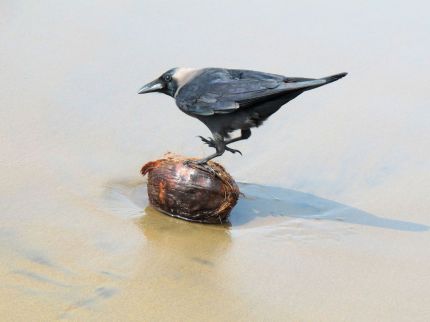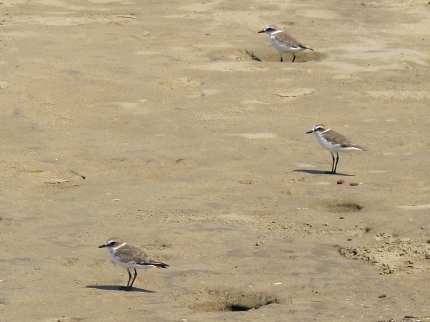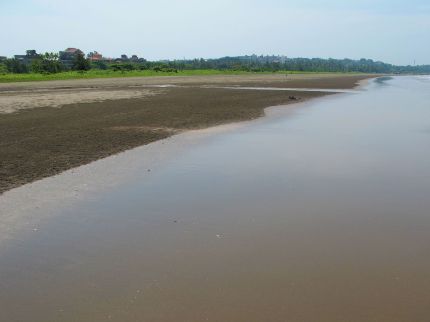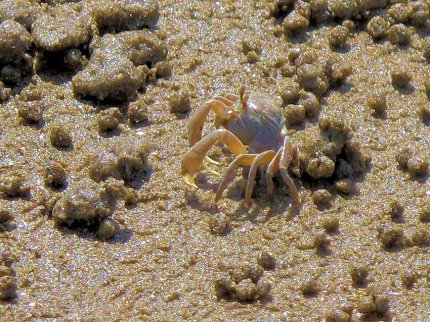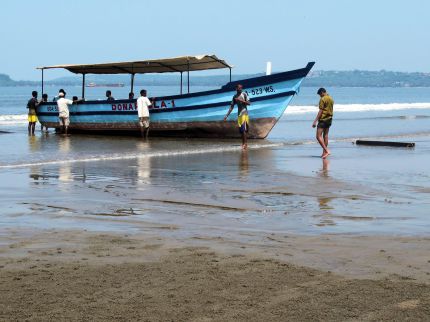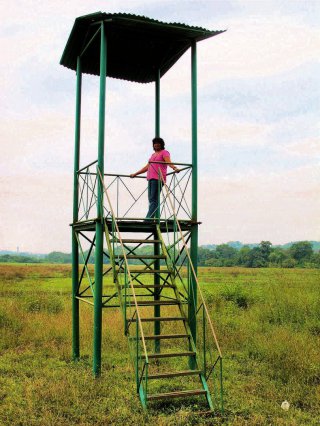
Wildlife Safaris
Miramar Beach Expedition
One particularly nice day my girlfriend had business to deal with in Panaji so I asked her to drop me at Miramar Beach. My plan was to walk back along the beach and cut back in to the main road at some indeterminate point to find my way back to the apartment. I carried my binoculars and camera and I was full of anticipation for my first lone adventure in Goa.
House crow trying to work out what to do with a coconut
It was a warm sunny morning as I crossed the sandy beach to get to the shore. I then strolled south-west along the shoreline. A Brahminy kite patrolled overhead. A coconut was being washed up on the shore. This coconut may not be Goan; it could be from any country around the Arabian Sea or even up from the Indian Ocean for all I knew.
Coconut palms thrive in sandy soils such as beaches. If a coconut falls into the sea, it can be taken by currents to swirl around the ocean and end up beached anywhere in the tropical regions of the world to grow into a new tree. The successful coconuts are probably those beached during storms when they land high above the normal shoreline. These coconuts will eventually lead to a line of coconut palms along the top of the beach.
I continued my stroll and saw a small group of waders were picking around the sand. I watched them intently as I approached and took them to be Kentish plovers. These were the first Kentish plovers I’d ever seen and it took a 6,000 mile trip to see them. How ironic.
From here on the beach had a very strange phenomenon. The damp area of sand was quite dark. It intrigued me and as I got closer I found the cause to be quite a surprise.
On closer inspection I could see that come kind of crabs had built underground chambers in the damp sand just above the flow line of the waves. This phenomenon stretched as far as the eye could see meaning that there must be billions upon billions of these chambers on this beach.
It occurred to me that this mega city of incalculable number of citizens must be rebuilt every day because the tide would surely destroy it each day.
Closer still I could see the small crabs creeping about the spoil of their work, some rivalries led to disputes. With some research I found that these were a species of sand bubbler crabs.
Sand bubbler crabs
These are small crabs that excavate burrows at low tide on sandy beaches in the tropical Indo-Pacific. They remain in their burrows during high tide, waiting out in a bubble of air. At low tide they emerge on to the surface of the sand, and pass the sand through their mouthparts, eating detritus and plankton, and discarding the processed sand as pellets.
The crabs work radially from the entrance to their burrows and colonies are vast, covering the high/low tidal of the whole beach. Each time the tide rises the sea water disintegrates the pellets. The burrows provide protection from predators and are indomitably defended against rivals. The resident rarely loses.
Sand bubbler crabs are of the genera Scopimera and Dotilla in the family Dotillidae. They are small, about 10mm (0·4in) across the carapace which is the shell of the main body of the crab.
A fishing boat back from a trip
I walked on for something like a mile, I came across a fishing community. Their homes among the palms behind the beach are basic and they are poor people. There was a small fleet of boats on the beach. Beyond this hundreds of jellyfish had been washed up on the shore.
Jellyfish
With later research I learned that they have no brain and the main body, its bell, is made of two thin layers of cells with non-living, watery material in between. This simple structure is an evolutionary trick which allows them to grow big and eat more things without the cost of a high metabolism. They have survived for over 600 million years.
I had gotten myself a bit lost because I couldn’t find my way off the beach. Then I recognised a playground that Sweetness and I had visited so I cut in and walked through. I had the feeling that the park was shut as the only people there were women squatted in a rough line cleaning and weeding the lawn. I went past the security house and through the gate which was ajar and noticed a sign that said ‘gates open at 4:00pm – trespassers will be prosecuted’. Thankfully there were no police around so I wasn’t prosecuted.
I walked back along the main road past the Swimsea Resort, the only resort on the beach side of the road. I finally found a road that I knew would take me back to Sweetness’ home. I had been out about 1 hour 30 minutes.
Today has been the best day for me personally so far. Getting out on my own and stroll at my own pace learning so much new. I didn’t feel ill at ease and people I passed exchanged pleasantries just like anywhere else. If you are a stranger anywhere in the world just be smart. Remain aware of your surroundings and the people around you, and don’t show off anything that looks valuable like a mobile, a camera, wallet or purse. Most of all be confident, friendly and disarming.
Carambolim Lake
First visit
In the first week of the expedition Rod took me to Carambolim Lake which lies to the east of Panaji to see the wildlife. He parked the car and we went down to the shore with me eagerly speculating on the prospect of seeing dangerous creatures such as crocodiles.
We found a small shallow slope leading into the water. An ideal spot for crocodiles to come ashore and eat us in my mind. It was quiet, too quiet. We foolishly edged forward with trepidation.
I was recalling in my mind documentaries that I’d seen about how crocodiles attack. They lay in wait for prey just under the surface near the shore where their prey can’t see them. A sudden flick of their massive tails propels them at speed out of the water to snatch their victim. I watched the water intently. We both did.
An urgent rustling in the bushes behind and to our left made us jump and swing round. Two mongooses broke cover to run past excitedly. That meant we now had a new thing to be wary of. The presence of mongooses means the presence of snakes, their main prey. We continued with even more trepidation along the track.
We found a lookout tower to view over the lake. Carambolim is a special place and I saw many different bird species but, me being me, I had forgotten to pack an Indian bird guide from England and the book shops in Panaji were shut for the first few days. I made the best notes that I could but I knew I’d have to come back when I had bought a bird guide. In fact I would visit twice more with either Rod or Sweetness.
This is my list from today. Some of these species I would come to identify later in the expedition.
-
Egret – several white, a couple with brown bodies
-
Heron - with brown neck with black stripe
-
Hawk – medium-sized, brown with white head
-
Turkey-like bird – with big black body and red spot on top of head
-
‘Kingfisher’ –on post but with a long tail
-
Mongoose – 2 ran by while we were waiting to be eaten by crocodiles
-
Yellow butterflies –many on the low bushes
Second visit
After siesta on a day halfway through the expedition, Sweetness and I went to Carambolim Lake. In spite of not having an international licence I drove and I was pleasantly surprised in how easily I found the way as I hadn’t been there for a month.
I learned a bit more about this wonderful place. It is owned by the government. It may seem neglected and forgotten but I prefer to think of it as wild and at least it can’t be spoilt by business development.
We went to the tower that me and Rod used before but it was occupied by a group of young men so we back-tracked and found another tower nearer the middle of the east shore.
We stayed until sunset and saw a good number of bird species including:
-
Little cormorant
-
Darter or snakebird
-
Great egret
-
Grey hornbill
-
White-breasted kingfisher
-
House crow
A Brahminy and a pariah kite were buzzing each other in dispute over territory or rivalry. There was also a bird which looked like a bay-backed shrike but had a forked tail. I could imagine spending a lifetime studying the wildlife here.
Third visit
On the last full day of my Goan adventure, Sweetness, Rod and I went to Carambolim Lake. In a field on the way we saw about 50 cattle egrets gathered round one cow. At Carambolim we parked the car on the east side of the lake. It was a bright morning but cloudy.
We went to the north tower for the view. Paddybirds stalked the shallows nearby but their plumage making them almost invisible until they opened their wings. Over half a dozen egrets were there along with whistling ducks. A red-wattled lapwing was close by and later flying. Pariah and Brahminy kites overhead. We also saw a white-breasted kingfisher and little cormorant.
A darter or snake bird did the trick of submerging its body leaving only its neck visible to us. I believe I also saw a brown shrike on the top of a shrub near the tower. There were few wading birds which I took to be some kind of rail. They were as big as a coot, perhaps slighter larger, with a dark iridescent blue/green body, the bill dark but they had a red cap.
Dr Sálim Ali Bird Sanctuary
On Sunday 26 September Sweetness, Rod and I went out at 09:30 to catch the ferry to Chorão Island. We were headed for the Dr Sálim Ali Bird Sanctuary. The entrance is close to the ferry terminal. We paid 50 rupees each and I paid 25 rupees for my camera. A one hour boat trip would apparently cost 1,000 rupees.
The size of the sanctuary is 440 acres of low thick mangrove forest, predominantly rhizophora mucronata and avicennia officinalis as well as other species. . It lies on the southern shore of Chorão Island in the Mandovi River and is named after Dr Sálim Ali, the eminent Indian ornithologist.
Of particular interest to me was the sign near the entrance which showed photographs of snakes of Goa. Before I came to Goa I speculated about seeing dangerous creatures. I would like to make it clear that I am a coward and any comments were made tongue in cheek.
The sign lists 18 non-venomous snakes described as ‘harmless’, 6 mildly venomous snakes also described as ‘harmless’. The last section was more worrying; 12 venomous snakes described as ‘harmful’. As we walked on the stepping stones I progressed with caution, looking in every direction including up.
Sweetness had hurt her leg a couple of weeks ago and, though it was healed, she felt a little weak and turned back about a hundred yards or so.
Rod and I went further into the mangrove swamp. We were both cautious of wildlife. I cautiously checked the branches all around looking for tree snakes, or rather looking for tree snakes that hopefully weren’t there.
This narrow path of stepping stones in this muddy swamp afforded only two directions of escape – onwards or backwards. If a situation occurred and we chose onwards we could end up trapped.
We continued into the thick mangrove swamp until we came to a visitor centre which was simply a corrugated metal roof shelter with some photographs of birds along the sides.
We went into the shelter and relaxed as at least we didn’t need to look up any more. We looked at the wildlife illustrations with interest and our fears subconsciously melted away.
There was an urgent scuffling on the roof right above heads. Then there was a high pitched squeal then nothing. We dashed outside to try to see what it was but the noise ad come from the blind side of the roof.
We went on and found a bench to rest on and speculated as to what caused the noise and thought that it may have been a rat or a squirrel being caught by a snake. Neither of us was going to attempt climbing to the roof to confirm our theory. It wasn’t long before we headed back for the car.
A disappointing visit in some ways. So close to a dangerous creature without seeing it but also no bird or other wildlife.
My name is Gary Flint. I'm author, photographer & illustrator for Postcards from Slough. If you wish to make any comments on the contents of the website please click on the ladybird below:
Gary Flint
08/03/1961 - 09/04/2019
Postcards from Slough is an independently funded website. We are open to offers of sponsorship from companies that have any connections to the town. To contact us please click on the ladybird below:
Chalvey Community Forum
Postcards from Slough is linked with a local action group the Chalvey Community Forum. The group liaises with various local organisations in order to improve the quality of life for residents in the ward of Chalvey and Salt Hill. To learn more please click on the maidenhair leaf below:
Museum of Berkshire Aviation
I volunteer as a guide at the Museum of Berkshire Aviation. It is a special museum and if you would like to know more about the museum then please click on the motif below:
To learn more about the museums activities while staying within this website click on the tab at the top of the page or on the motif below:
Graces Guide
Postcards from Slough uses some images from Grace's Guide. Click on the button below:
British Listed Buildings
Postcards from Slough contributes material to British Listed Buildings and uses the site for cross referencing purposes. Click on the button below:
